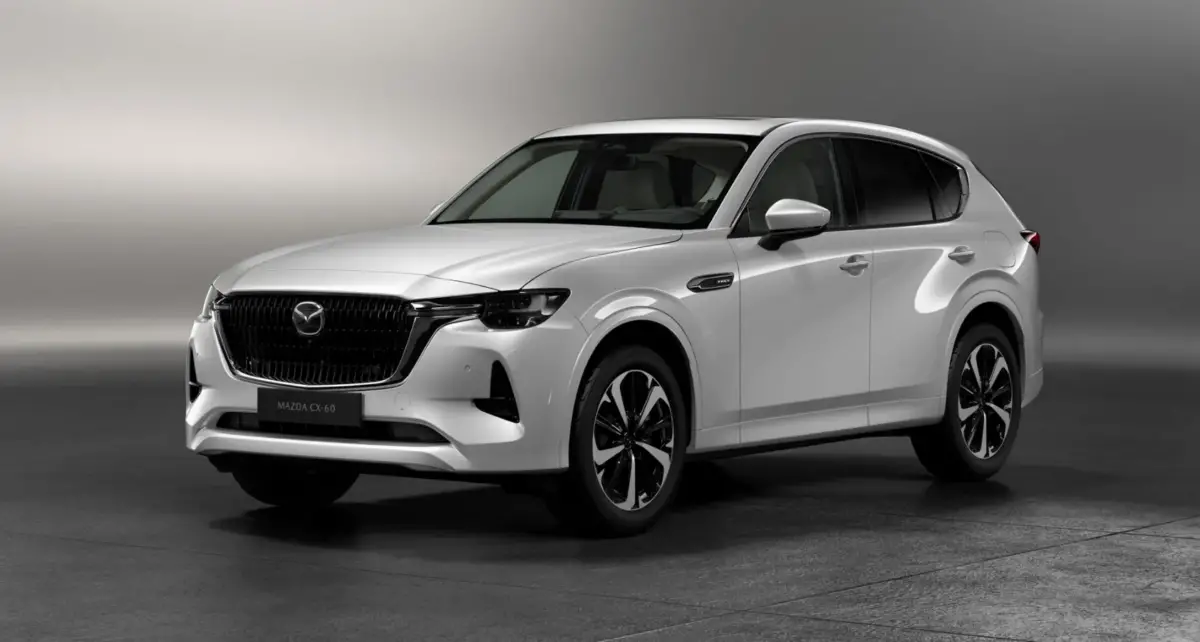
2025 Mazda CX-70 Radar Sensors Owner’s Manual
The radar sensors in the 2025 Mazda CX-70 act as watchful sentinels, ready to identify and foresee possible threats, as you drive beside them. The addition of radar sensors to the CX-70 is just one example of Mazda’s dedication to safety in a time when technology breakthroughs are redefining what it means to drive. These advanced sensors use radar technology to monitor the surroundings with unmatched precision.
2023 – 2024 MAZDA MX-5 MIATA Specs, Price, Features, Mileage (Brochure)
Radar Sensors
The radar sensor detects objects by sending radio waves in a specific direction and receiving the reflected waves back.
Vehicle front

- Front radar sensor
- Front side radar sensors*
Vehicle rear
- Rear side radar sensors
CAUTION
- Heed the following cautions so that the radar sensors can function normally.
- Do not modify the suspensions.
- Use the specified tire size and the same type of tire on all 4 wheels. In addition, do not use tires with significantly different wear patterns or tire pressures on the same vehicle (including temporary spare tire).
- Do not spray highly pressurized water against the radar sensors or rub them strongly.
- Do not apply stickers on parts near the radar sensors.
- If foreign matter adheres to parts near the radar sensors, remove it and switch the vehicle power OFF. The foreign matter detection status is reset by switching the vehicle power OFF.
- Do not install any parts that cover the front of the radar sensors.
- Do not replace the radiator grille and emblem with anything other than genuine products.
- If strong force is applied to parts near the radar sensors, the direction of the radar sensor may become deviated and each system may not operate normally. Stop each system immediately and have the vehicle inspected by an Authorized Mazda Dealer.
NOTE
The radar sensors include a function for detecting abnormalities in the sensor, soiling of the sensor’s front surface, and informing the driver. If a message appears on the screen that can be addressed, follow the directions of the message.
Front radar sensor
The following systems utilize the front radar sensor.
- Distance & Speed Alert (DSA)
- Mazda Radar Cruise Control (MRCC)
- Cruising & Traffic Support (CTS)
- Smart Brake Support (SBS) forward drive detection
NOTE
- When driving on roads with few vehicles ahead, a message maytemporarily be displayed on the screen indicating that the front radar sensor is dirty.
- When the vehicle is driven on roads in which there is an elevated road on one side, the front radar sensor function may be restricted temporarily.
- If the lead-acid battery power is weak, the front radar sensor detection function may decrease and each system may not operate normally.
- When any of the following conditions is met, the front radar sensor may not be able to detect vehicles ahead or obstructions correctly.
- During inclement weather.
- Front visibility is reduced.
- The vehicle is driven near facilities or objects emitting strong radio waves.
- The rear surface of a vehicle ahead does not reflect radio waves effectively.
- A vehicle ahead has limited areas that can reflect radio waves.
- Your vehicle is tilted.
- Foreign matter is adhering to parts near the front radar sensor.
- When any of the following conditions is met, the front radar sensor may detect vehicles in the adjacent lane or surrounding obstructions, or it may not be able to detect vehicles ahead or obstructions.
- The vehicle is entering or exiting a curve.
- The vehicle is driven on a continuously curving road.
- The vehicle is driven on roads with repeated up and downslopes.
- The vehicle is driven on roads with narrow lanes.
- The vehicle is driven on poor roads or unpaved roads.
- The vehicle ahead enters the front radar sensor’s blind spot.
- The distance to the vehicle ahead is extremely close.
- The vehicle ahead is being driven in an unstable condition.
- A vehicle suddenly comes close such as by cutting into your lane.
Front-side radar sensors
The following system utilizes front-side radar sensors.
- Front Cross Traffic Alert (FCTA)
- Smart Brake Support (SBS) Front Crossing
NOTE
- When any of the following conditions is met, the front-side radar sensors may not be able to detect target objects.
- During inclement weather.
- The vehicle is driven on a sharp curve or on bumpy roads.
- A radar sensor from an adjacent vehicle causes radio wave interference.
- The detection range of a front-side radar sensor is obstructed by an adjacent wall or vehicle, or the radar is reflected.
- A vehicle suddenly enters the detection range from the front or side of your vehicle.
- The target object is extremely small.
- The target object is extremely low/ high.
- A vehicle approaches while turning.
- A vehicle that has stopped suddenly starts to move.
- Multiple objects move at the same time.
- The bumper around a front side radar sensor is deformed.
- Foreign matter is adhering to the bumper around a front side radar sensor.
- The temperature near a front side radar sensor is extremely hot.
- The front side radar sensors may not detect the following target objects.
- Animals.
- Pedestrians.
- Bicycles and small motorcycles moving at a low speed.
- Shopping carts.
- Stationary objects on the road or roadside.
- Vehicles with shapes that may not reflect radar waves.
Rear side radar sensors
The following systems utilize rear side radar sensors.
- Blind Spot Monitoring (BSM)
- Blind Spot Monitoring (BSM) Vehicle Exit Warning
- Rear Cross Traffic Alert (RCTA)
- Smart Brake Support (SBS) Rear Crossing
- Emergency Lane Keeping (ELK) Blind Spot Assist
NOTE
- When any of the following conditions is met, the rear side radar sensors may not be able to detect target objects.
- During inclement weather.
- The vehicle is driven on a sharp curve or on bumpy roads.
- Radar sensor from an adjacent vehicle causes radio wave interference.
- The detection range of a front side radar sensor is obstructed by an adjacent wall or vehicle, or the radar is reflected.
- A vehicle suddenly enters the detection range from the front or side of your vehicle.
- The target object is extremely small.
- The target object is extremely low/ high.
- A vehicle approaches while turning.
- A vehicle that has stopped suddenly starts to move.
- Multiple objects move at the same time.
- The bumper around a rear side radar sensor is deformed.
- Foreign matter is adhering to the bumper around a rear side radar sensor.
- The temperature near a rear side radar sensor is extremely hot.
- When towing a trailer.
- The rear side radar sensors may not detect the following target objects.
- Animals.
- Pedestrians.
- Bicycles and small motorcycles moving at a low speed.
- Shopping carts.
- Stationary objects on the road or roadside.
- Vehicles with shapes that may not reflect radar waves.
- A vehicle is traveling alongside your vehicle at nearly the same speed for an extended period of time.
FAQs
The Mazda CX-70 radar sensors are responsible for detecting objects and vehicles in the vicinity of the vehicle, providing critical data for various safety and systems.
The Mazda CX-70 typically features multiple radar sensors strategically positioned around the vehicle to provide comprehensive coverage of the surrounding environment.
The radar sensors in the Mazda CX-70 utilize advanced radar technology, such as millimeter-wave radar, to accurately detect objects and obstacles in real-time.
The radar sensors play a key role in collision avoidance systems by detecting potential hazards and providing early warnings to the driver or triggering automatic braking interventions to mitigate or prevent collisions.
Yes, the radar sensors are often integrated into blind-spot monitoring systems, allowing them to detect vehicles in adjacent lanes and alerting the driver to potential blind spot hazards.
The radar sensors enable adaptive cruise control systems in the Mazda CX-70 to maintain a safe following distance from the vehicle ahead by continuously monitoring the distance and relative speed of other vehicles.
The radar sensors undergo rigorous testing and calibration procedures during manufacturing to ensure accuracy and reliability under various driving conditions and environments.
The Mazda CX-70 radar sensors may feature adaptive algorithms that adjust their sensitivity and operating parameters to accommodate changes in driving conditions such as weather, road surface, and traffic density.
Yes, factors such as heavy rain, fog, or snow may affect the performance of radar sensors in the Mazda CX-70 by reducing their range and accuracy.
The radar sensors may be utilized in pedestrian detection systems to detect pedestrians in the vehicle’s path and trigger warnings or automatic braking interventions to prevent collisions.
The radar sensors are instrumental in cross-traffic alert systems, detecting approaching vehicles from the side and alerting the driver to potential cross-traffic hazards when reversing.
By continuously monitoring the surrounding environment and providing early warnings to the driver, the radar sensors enhance overall driving safety in the Mazda CX-70 by helping to prevent collisions and accidents.
Useful Links
2023 – 2024 MAZDA MX-5 MIATA Specs, Price, Features, Mileage (Brochure)

